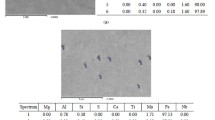Abstract
The authors have analyzed the necessity to improve the composition of existing critical structural materials for the purpose of developing metal matrix materials, which combine a highly plastic metal base and high-melting, high-strength, high-modulus fillers. Dispersed yttrium oxide (Y2O3) particles are preferred for iron matrix alloys, because of their stability at pyrometallurgical process temperatures and inertness to alloy components. The manufacturing of new materials by addition of dispersed particles into a liquid melt during casting using a centrifugal casting machine to obtain a hollow (pipe) billet is considered. The potential for improving the mechanical and operational properties of metal matrix materials in comparison with the monomaterial is demonstrated. This paper describes the thermodynamic modeling of high-temperature processes in the yttrium oxide–metal matrix (melt) system. The modeling has been carried out using the FactSage software package. A composition corresponding to 12Cr18Ni10Ti (12Kh18N10T) steel was used to model the matrix material. The calculations have been based on the ratio of 1 g of yttrium oxide additive per 100 g of matrix metal melt. It can be concluded based on the modeling results that the added dispersed yttrium oxide powder does not interact with alloy components, does not dissociate, and does not undergo allotropic transformations. The experiments on production of centrifugal castings using yttrium oxide as a strengthening phase with the aim of increasing radiation resistance have been proved to be expedient. The developmental focus of the most effective technology for creating metallic materials based on iron matrix dispersed-hardened with yttrium oxide has been established.


Similar content being viewed by others
REFERENCES
Val’ter, A.I. and Protopopov, A.A., Osnovy liteinogo proizvodstva (Principles of Foundry Technology), Moscow: Infra-Inzheneriya, 2019.
Odarchenko, I.B. and Nekrasov, G.B., Osnovy tekhnologii liteinogo proizvodstva. Plavka, zalivka metalla, kokil’noe lit’e (Principles of Foundry Technology: Melting, Metal Casting, and Chill Casting), Moscow: Vysshaya Shkola, 2013.
Komshukov, V.P., Cherepanov, A.N., Protopopov, E.V., et al., Influence study of metal modification with nanopowder materials on continuously cast rod billet quality, Influence of nanopowder modification of metal on the quality of continuous-cast bar, Steel Transl., 2010, vol. 40, no. 8, pp. 717–722.
Al-Mangour, B., Grzesiak, D., and Yang, J.-M., In‑situ formation of novel TiC-particle-reinforced 316L stainless steel bulk-form composites by selective laser melting, J. Alloys Compd., 2017, vol. 706, pp. 409–418.
Ivanov, I.I. and Demidik, A.N., Ferritic dispersion hardened steels of the hot zone of fast nuclear reactors, Vopr. At. Nauki Tekh., 2001, no. 4, pp. 65–68.
Singla, S., Grewal, J.S., and Kang, A.S., Wear behavior of weld overlays on excavator bucket teeth, Procedia Mater. Sci., 2014, vol. 5, pp. 256–266.
Portnoi, N.I., Babich, B.I., and Svetlov, I.L., Kompozitsionnye materialy na nikelevoi osnove (Nickel-Based Composite Materials), Moscow: Metallurgiya, 1976.
Belyanchikov, L.N., Rational process of production of corrosion-resistant ferritic steel with nanocluster oxide hardening for atomic power engineering, Russ. Metall. (Engl. Transl.), 2012, vol. 2012, no. 6, pp. 461–467.
Antsiferov, V.N., Bobrov, G.V., Druzhinin, L.K., et al., Poroshkovaya metallurgiya i napylenie pokrytii (Powder Metallurgy and Coating Spraying), Moscow, 1987.
Antsiferov, V.N. and Perel’man, V.E., Mekhanika protsessov pressovaniya poroshkovykh i kompozitsionnykh materialov (Mechanics of the Processes of Pressing Powder and Composite Materials), Moscow: Graal’, 2001.
Harris, I.R. and Williams, A.J., Grain Boundaries: Their Character, Characterisation and Influence on Properties, London: IOM Commun., 2001.
Benjamin, J.S. and Mercer, P.D., Dispersion strengthened superalloys mechanical alloying, Metall. Mater. Trans. A, 1970, vol. 1, no. 10, pp. 2943–2951.
Badmos, A.V. and Bhadeshia, H.K.D.H., The evolution of solutions: thermodynamic analysis of mechanical alloying, Metall. Mater. Trans. A, 1997, vol. 28, pp. 2189–2194.
Olier, P., Mabaplate, J., Mathon, M.H., et al., Structural and chemical characterizations of ODS ferritic steels produced by mechanical extrusion, Proc. Powder Metallurgy World Congr. and Exhibition, October 10–14,2010, Florence, 2010, pp. 151–158.
Chumanov, V.I., Anikeev, A.N., and Chumanov, I.V., RF Patent 2443505, 2012.
Chumanov, I.V., Chumanov, V.I., and Anikeev, A.N., Preparation of precipitation-strengthened hollow billets for rotary dispersers, Metallurgist, 2011, vol. 55, nos. 5–6, pp. 439–443.
Chumanov, I.V., Kareva, N.T., Chumanov, V.I., et al., Study and analysis of the structural constituents of billets hardened by fine-grained particles and formed by centrifugal casting, Russ. Metall. (Engl. Transl.), 2012, vol. 2012, no. 6, pp. 540–543.
Naizabekov, A.B., Panin, E.A., Lezhnev, S.N., et al., Study of the effect of radial-shear rolling on microstructure and mechanical properties of 08Cr18Ni10Ti stainless steel, Materialy Yubileinoi Mezhdunarodnoi nauchno-prakticheskoi konferentsii “Sovremennye innovatsii v oblasti nauki, tekhnologii i integratsii znanii” (Proc. Jubilee Int. Sci.-Pract. Conf. “Modern Innovations in Science, Technology and Knowledge Integration”), Rudnyi: Rudn. Ind. Inst., 2019, no. 7, pp. 197–204.
Naizabekov, A.B., Lezhnev, S.N., Arbuz, A.S., et al., Computer modeling of radial-shear rolling of austenitic stainless steel AISI-321, Mach. Technol. Mater., 2018, vol. 12, no. 12, pp. 497–500.
Bale, C.W., Bélisle, E., Chartrand, P., et al., FactSage thermochemical software and databases—recent developments, CALPHAD: Comput. Coupling Phase Diagrams Thermochem., 2009, vol. 33, pp. 295–311.
Bale, C.W., Bélisle, E., Chartrand, P., Decterov, S.A., et al., FactSage thermochemical software and databases, 2010–2016, CALPHAD: Comput. Coupling Phase Diagrams Thermochem., 2016. vol. 55, pp. 35–53.
Funding
This study was supported by the Ministry of Science and Higher Education of the Russian Federation under a Federal Target Program in accordance with Agreement no. 05.608.21.0276 dated December 4, 2019 (project no. RFMEFI60819X0276).
Author information
Authors and Affiliations
Corresponding authors
Additional information
Translated by E. Maslennikova
About this article
Cite this article
Chumanov, V.I., Chumanov, I.V. Potential for Using Yttrium Oxide Powder as a Strengthening Phase for Centrifugal Casting of Corrosion-Resistant Steels. Steel Transl. 50, 434–437 (2020). https://doi.org/10.3103/S0967091220070050
Received:
Revised:
Accepted:
Published:
Issue Date:
DOI: https://doi.org/10.3103/S0967091220070050




